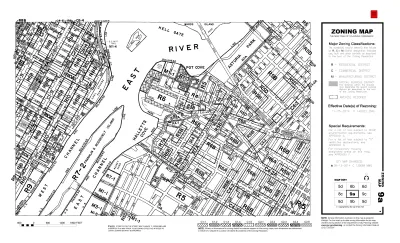A new database measures the restrictiveness of exclusionary zoning practices around the country. Exclusionary zoning, it turns out, is much more prevalent than commonly acknowledged.

The Eviction Lab has created a new tool to document exclusionary zoning practices around the United States as a first step creating the new housing necessary to ease rising housing costs in communities.
Writing for the Eviction Lab, Matt Mleczko and Matthew Desmond introduce the challenge of reforming zoning when so little is known about zoning in the aggregate.
“Zoning is fundamental to the make-up of our communities and our neighborhoods, but understanding these regulations and how they vary within and between places is enormously challenging. In large part, that’s because we lack straightforward, nationwide data,” according to the article.
Mleczko, Desmond, and the team at the Eviction Lab are attempting to fill that void with the launch of the National Zoning and Land Use Database (NZLUD). The duo have also authored an article for the Urban Studies journal to describe the process of creating the NZLUD, and have shared their data and code on GitHub.
The process created a metric the team dubbed the Zoning Restrictiveness Index (ZRI) to compare the restrictiveness of development regulations across jurisdictions. “We find highly-restrictive zoning policies in some of the coastal metro areas you might expect—Washington DC, New York, Seattle—but also in rustbelt metro areas like Milwaukee and Detroit,” write Mleczko and Desmond. “This underscores that exclusionary zoning is more common than many have acknowledged, both across and within metro areas.”
As measured by the ZRI, the most restrictive metropolitan areas are 1) Washington-Arlington-Alexandria, DC-VA-MD-WV; 2) New York-Northern New Jersey-Long Island, NY-NJ-PA; 3) Providence-New Bedford-Fall River, RI-MA; 4) Seattle-Tacoma-Bellevue, WA; and 5) Tampa-St. Petersburg-Clearwater, FL.
The remainder of the top ten, which, perhaps shockingly, does not include any Californian metropolitan areas, can be found at the link below. Example maps of depicting ZRI quintiles for the San-Francisco-Oakland-Fremont metropolitan statistical area (MSA) and the Houston-Sugar Land-Baytown MSA are also included.
FULL STORY: To reform exclusionary zoning, we first need to document it. Now we have a tool for that.

Analysis: Cybertruck Fatality Rate Far Exceeds That of Ford Pinto
The Tesla Cybertruck was recalled seven times last year.

National Parks Layoffs Will Cause Communities to Lose Billions
Thousands of essential park workers were laid off this week, just before the busy spring break season.

Retro-silient?: America’s First “Eco-burb,” The Woodlands Turns 50
A master-planned community north of Houston offers lessons on green infrastructure and resilient design, but falls short of its founder’s lofty affordability and walkability goals.

Test News Post 1
This is a summary

Analysis: Cybertruck Fatality Rate Far Exceeds That of Ford Pinto
The Tesla Cybertruck was recalled seven times last year.

Test News Headline 46
Test for the image on the front page.
Urban Design for Planners 1: Software Tools
This six-course series explores essential urban design concepts using open source software and equips planners with the tools they need to participate fully in the urban design process.
Planning for Universal Design
Learn the tools for implementing Universal Design in planning regulations.
EMC Planning Group, Inc.
Planetizen
Planetizen
Mpact (formerly Rail~Volution)
Great Falls Development Authority, Inc.
HUDs Office of Policy Development and Research
NYU Wagner Graduate School of Public Service




























